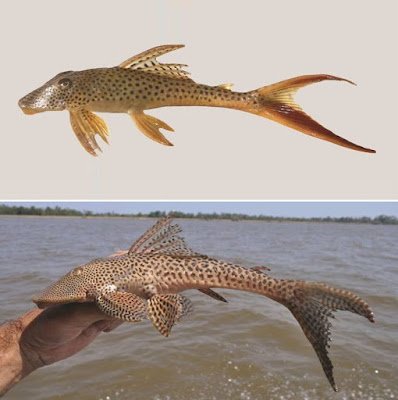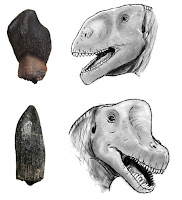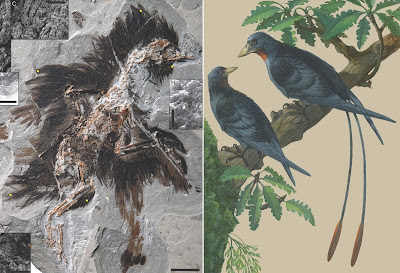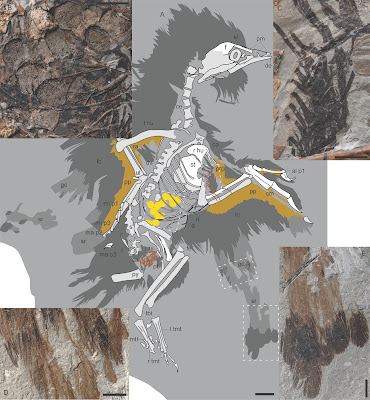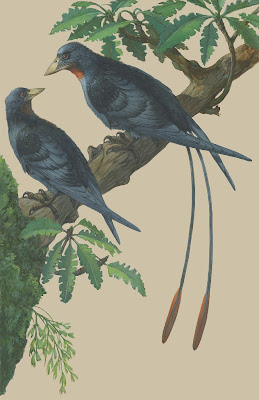[Most Recent Entries] [Calendar View]
Friday, March 31st, 2017
| Time | Event | ||||
| 4:27p | [Ichthyology • 2017] Aphanotorulus rubrocauda • A New Species of Aphanotorulus (Siluriformes: Loricariidae) from the rio Aripuanã basin, Brazil
ABSTRACT The cis-Andean genus Aphanotorulus was recently revised and comprises six valid species: A. ammophilus, A. emarginatus, A. gomesi, A. horridus, A. phrixosoma and A. unicolor. Herein, a new species is described from tributaries of the rio Aripuanã basin, in Amazonas and Mato Grosso states, Brazil. The new species is easily distinguished from congeners by its color pattern: caudal fin with upper lobe mostly hyaline with dark spots along rays and membranes, and lower lobe red and without dark spots; and absence of dark spots in the lateral series of mid-ventral plates. Keywords: Amazon basin; Fishes; Hypostominae; Taxonomy Diagnosis. Aphanotorulus rubrocauda can be distinguished from all other species of Aphanotorulus by its color pattern: having a uniformly red colored lower caudal-fin lobe (vs. lower lobe of caudal fin with dark spots on creamy colored background), by the absence of dark spots on the posterior half of mid-ventral lateral plate series (vs. presence of dark spots in all lateral plate series). Additionally, Aphanotorulus rubrocauda is distinguished from congeners by having more premaxillary teeth (32-65 per ramus, mean = 45; vs. 15-34, mean = 24) and dentary teeth (30-63 per ramus, mean = 44; vs. 14-34, mean = 25). Aphanotorulus rubrocauda further differs from A. emarginatus by having small round dark spots (vs. dark large and elongated spots) (Fig. 3). Andreza S. Oliveira, Lúcia Rapp Py-Daniel and Cláudio H. Zawadzki. 2017. A New Species of Aphanotorulus (Siluriformes: Loricariidae) from the rio Aripuanã basin, Brazil. Neotropical Ichthyology. 15(1); e160034. DOI: 10.1590/1982-0224-20160034. | ||||
| 4:44p | [Paleontology • 2017] Sauropod Tooth Morphotypes from the Upper Jurassic of the Lusitanian Basin (Portugal)
Abstract The Upper Jurassic of the Lusitanian Basin has yielded an important fossil record of sauropods, but little information is available about the tooth morphotypes represented in this region. A large sample of teeth, both unpublished and published, is described and discussed here. Four main tooth morphologies are identified: spatulate, heart-shaped, pencil-shaped, and compressed cone-chisel-shaped. Heart-shaped teeth are considered to be exclusive to a non-neosauropod eusauropod, tentatively referred to Turiasauria. The spatulate teeth can be attributed to members of the Macronaria; they have a complex cingulum, more than one lingual facet and a labial ridge. The compressed cone-chisel-shaped teeth are also attributed to macronarians and the presence of an axially twisted apex through an arc of 30°–45° suggests putative affinities with Europasaurus and basal titanosauriforms. The variability observed in the overall morphology and wrinkling pattern of the compressed cone-chisel-shaped teeth may be due to factors related to the tooth position or to the ontogeny of individuals. Finally, pencil-shaped teeth with high slenderness index values, oval and apically located wear facets, subcylindrical crowns and lacking carinae, are tentatively assigned to Diplodocoidea. The diversity of tooth morphologies is in accordance with the known palaeobiodiversity of the Portuguese Late Jurassic sauropod fauna, which is composed of non-neosauropod eusauropods (turiasaurs), diplodocoids (diplodocids) and macronarians (camarasaurids and probably brachiosaurids). The Late Jurassic sauropod fossil record of the Iberian Peninsula presents the broadest tooth morphospace range in the world from this period, suggesting a wide niche partition for sauropods, and corresponding high taxonomic diversity. Keywords: tooth morphology; Lusitanian Basin; Upper Jurassic; Sauropoda; Eusauropoda; Neosauropoda Pedro Mocho, Rafael Royo-Torres, Elisabete Malafaia, Fernando Escaso and Francisco Ortega. 2017. Sauropod Tooth Morphotypes from the Upper Jurassic of the Lusitanian Basin (Portugal). Papers in Palaeontology. DOI: 10.1002/spp2.1075 La diversidad de dinosaurios de Portugal es mayor de lo que se pensaba agenciasinc.es/Noticias/La-diversidad-de-d | ||||
| 4:52p | [Mammalogy • 2017] A Taxonomic Revision of the Kerivoula hardwickii complex (Chiroptera: Vespertilionidae) with the Description of A New Species, Kerivoula furva, from Taiwan Abstract Since its discovery, the taxonomic status of the only species of Kerivoula (Chiroptera: Vespertilionidae: Kerivoulinae) to be found on Taiwan has been confused. Previous studies have assigned this species to either Kerivoula hardwickii or K. titania, both of which occur on continental SE Asia. This uncertainty supports repeated suggestions in the literature that specimens of K. hardwickii collected and/or sampled across SE Asia are likely to represent multiple cryptic taxa. To address these issues, we combined new and existing data from the genus Kerivoula on Taiwan and continental Asia, and performed diagnostic analyses in steps. First, phylogenetic reconstructions based on mitochondrial and nuclear DNA revealed a well-supported group comprising all taxa currently recognized as K. hardwickii, together with the Taiwanese Kerivoula and Kerivoula kachinensis to the exclusion of all other congeneric species. Second, focusing on all members of this monophyletic clade (i.e., K. hardwickii complex) together with K. titania, we used multivariate statistical methods to separate taxa based on morphometric data. Our results provide strong evidence that among these bats, the Taiwanese Kerivoula is a new species that also occurs on continental Asia, for which we provide a formal description and name. In addition, we show that the subspecies K. hardwickii depressa should be elevated to species status [Kerivoula depressa]. We discuss our findings and the caveats of this and similar studies. Kerivoula furva sp. n. Etymology: The proposed English name is ‘Dark woolly bat’.The name refers to the very dark pelage of the new species. Hao-Chih Kuo, Pipat Soisook, Ying-Yi Ho, Gabor Csorba, Chun-Neng Wang and Stephen J. Rossiter. 2017. A Taxonomic Revision of the Kerivoula hardwickii complex (Chiroptera: Vespertilionidae) with the Description of A New Species. Acta Chiropterologica. 19(1); 19-39. DOI: 10.3161/15081109ACC2017.19.1.002 | ||||
| 4:52p | [PaleoOrnithology • 2017] Exceptional Preservation of Soft Tissue in A New Specimen of Eoconfuciusornis and Its Biological Implications
Abstract We report on an exceptional specimen of Eoconfuciusornis preserving rare soft-tissue traces of the ovary and wing. Ovarian follicles preserve a greater hierarchy than observed in Jeholornis and enantiornithines, suggesting confuciusornithiforms evolved higher rates of yolk deposition in parallel with the neornithine lineage. The preserved soft tissues of the wing indicate the presence of a propatagium and postpatagium, whereas an alular patagium is absent. Preserved remnants of the internal support network of the propatagium bear remarkable similarity to that of living birds. Soft tissue suggests the confuciusornithiform propatagium could maintain a cambered profile and generate lift. The feathers of the wing preserve remnants of their original patterning; however, this is not strongly reflected by observable differences under scanning electron microscopy (SEM). The tail plumage lacks elongate rectrices, suggesting that the earliest known confuciusornithiforms were sexually dimorphic in their plumage. Keywords: Huajiying, Jehol Biota, Aves, Confuciusornithiformes, propatagium, feathers
Xiaoting Zheng, Jingmai K. O’Connor, Xiaoli Wang, Yanhong Pan, Yan Wang, Min Wang and Zhonghe Zhou. 2017. Exceptional Preservation of Soft Tissue in A New Specimen of Eoconfuciusornis and Its Biological Implications. National Science Review. nwx004. DOI: 10.1093/nsr/nwx004 Scientists make new discovery about bird evolution Summary: A team of scientists has described the most exceptionally preserved fossil bird discovered to date, in a newly published article. The new specimen from the rich Early Cretaceous Jehol Biota (approximately 131 to 120 million years old) is referred to as Eoconfuciusornis, the oldest and most primitive member of the Confuciusornithiformes, a group of early birds characterized by the first occurrence of an avian beak. | ||||
| 4:56p | [Ornithology • 2017] Phylogeography of Bulbuls in the Genus Iole (Aves: Pycnonotidae)
Abstract Southeast Asia is one of the most geologically dynamic regions of the world with great species diversity and high endemism. We studied the bulbuls of the south and southeast Asian genus Iole (Aves: Pycnonotidae) in order to analyse their evolutionary relationships and describe their patterns of diversification and delimit species boundaries. Our phylogeographic reconstruction, based on two mitochondrial and one nuclear markers, sampled from all 13 recognized Iole taxa, presently grouped as four species, revealing three primary lineages: (1) a Palawan lineage (2) a Sundaic group distributed in the Malay Peninsula, Sumatra and Borneo and (3) an Indochinese group distributed throughout continental Southeast Asia. Divergence time estimation suggested that the Palawan lineage diverged during the Miocene (around 9.7 Mya), a later split between the Sundaic and Indochinese lineages occurring around 7.2 Mya. The present classification of Iole based on morphology does not accurately reflect taxonomic relationships within the genus, in which we recognize five more putative species. An integrative approach that incorporates morphology and bioacoustics should further refine our understanding of species limits among Iole taxa. Keywords: Iole, phylogeny, phylogeography, pycnonotidae, species tree Sontaya Manawatthana, Parames Laosinchai, Nuttaphon Onparn,Warren Y. Brockelman and Philip D. Round. 2017. Phylogeography of Bulbuls in the Genus Iole (Aves: Pycnonotidae). Biol. J. Linn. Soc. 120(4); 931-944.. DOI: 10.1093/biolinnean/blw013 สรุปคร่าวๆเฉพาะส่วนของประเทศไทย นกปรอดสกุล Iole (อ่านว่า ไอโอลี่) เดิมพบได้ในไทย 3 ชนิดคือ 1.) นกปรอดเล็กตาขาว (Grey-eyed Bulbul; Iole propinqua) 2.) นกปรอดเล็กสีไพลตาแดง (Olive Bulbul; Iole viridescens) 3.) นกปรอดหงอนตาขาว (Buff-vented Bulbul; Iole charlottae) ทั้งสามชนิดมีลักษณะภายนอกใกล้เคียงกันมาก ซึ่งผลจากการศึกษานี้ทำให้มีนกชนิดใหม่ของ 4.) Baker’s Bulbul (Iole cinnamomeoventris; ยังไม่มีชื่อภาษาไทยอย่างเป็นทางการ) - นกชนิดใหม่นี้เดิมถูกจัดเป็นเพียงชนิดย่อย - แต่จากการวิเคราะห์ DNA พบว่ามันมีความแตกต่างในเชิงวิวัฒนาการมาก - พบในภาคใต้ของไทย บริเวณด้ามขวานตั้งแต่ราวๆ จ.เพชรบุรีลงไปถึงราวๆ จ.สงขลา - ลักษณะที่ใช้จำแนกในภาคสนามได้ดีที่สุดคือ ตัวอย่างเสียงของ Iole cinnamomeoventris http://www.xeno-canto.org/336909 ตัวอย่างเสียงของ ปรอดหงอนตาขาว Iole charlottae http://www.xeno-canto.org/336936 - ชื่อ Baker's Bulbul ตั้งเพื่อเป็นเกียรติแก่ E. C. Stuart Baker นักปักษีวิทยาชาวอังกฤษ ซึ่งเป็นคนแรกที่จำแนกชนิดย่อย cinnamomeoventris นี้ไว้เมื่อปี 1917 -------------------------------- ถ้านับรวมทั้งเอเชียตะวันออกเฉียงใต้ เดิมนกปรอดสกุลนี้มีทั้งหมด 4 ชนิด ผล DNA จากการศึกษานี้บ่งชี้ว่าควรจะจำแนกเพิ่มอี ทั้งนี้ เปเปอร์แรกนี้จะเน้นเฉพาะผลจากการวิเคราะห |
| << Previous Day |
2017/03/31 [Calendar] |
Next Day >> |
